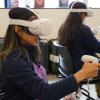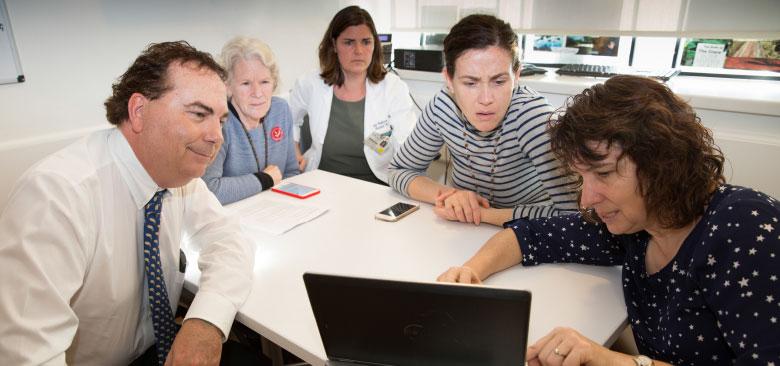
Pharmacist Mark Holtsman (left), chaplain Denah Joseph, palliative care physician Wendy Anderson, social worker Bridget Sumser and nurse practitioner Doranne Donesky lead an interprofessional continuing education course. (Elisabeth Fall Photography)
Health Systems, Educators Improvise to Bring Palliative Care to Patients
In 2015, Washington Hospital Healthcare System in Fremont, California, offered nurse practitioner Bernardita Roe (MS ’02) the chance to play a central role in developing the infrastructure for an inpatient palliative care consultative team.
Roe had turned down a similar offer a couple of years earlier, but her time at the Stanford Cancer Center sparked her interest to better understand the depth and breadth of a specialty that goes far beyond end-of-life care to embrace supportive care for anyone with a serious illness. Studies have shown that patients who receive quality palliative care report improvement in pain and other symptoms, better communication with health care providers and family members, enhanced emotional support and care that is more aligned with their individual wishes.
Hoping to fully prepare for her new role, Roe took the advice of Stanford nursing colleagues Judy Passaglia (MS ’97) and Garrett Chan (MS ’00, PhD ’05), who are both clinical faculty members at UC San Francisco School of Nursing, and enrolled in an interprofessional continuing education course at the School.
Nurse practitioner and School of Nursing professor DorAnne Donesky initially conceived the course with palliative care physician and School of Medicine associate professor Wendy Anderson in response to a rapidly growing need. The program is one of the few of its kind in the country, and Roe found that it provided her with a comprehensive understanding of palliative care as she tackled everything from integrating the consultative service into existing practices, revising the hospital’s electronic health record (EHR) and correcting the still common misperception among her colleagues and patients that equates palliative care with end-of-life care.
She did all this with a team that fell short of Joint Commission guidelines, which recommend each hospital have a full-time palliative care team composed of a physician, an advanced practice or other registered nurse, a social worker and a chaplain. At least initially, Roe’s team was made up of herself, two part-time physicians, a full-time coordinator, and a social worker and a chaplain, each at 25 percent time.
This type of improvisation is hardly unusual. Director of the UCSF Health Workforce Research Center on Long-Term Care Joanne Spetz – who is also on faculty at the School of Nursing – recently published a piece in Health Affairs indicating that the overwhelming majority of hospitals are trying to make palliative care work in conditions that are a long way from ideal.
Early Days of Palliative Care Integration
The Health and Medicine Division of the National Academies of Sciences, Engineering, and Medicine (formerly the Institute of Medicine) has recommended that all Americans with advanced illness have access to palliative care services provided by well-trained interprofessional teams. Yet when Spetz and her team reviewed data from the 2012-13 annual surveys of the National Palliative Care Registry, they found that palliative care programs reached only a median of 3.4 percent of hospital patients. Only 25 percent of programs have a complete team, per the Joint Commission’s recommendations, and a third of all programs could not provide the recommended coverage on-site during all weekday business hours.
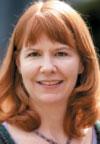 Joanne Spetz Even when unfunded positions were included, only 39 percent of programs met the standard. “It was pretty stunning the extent to which these programs are dependent on in-kind contributions of professionals,” says Spetz.
Joanne Spetz Even when unfunded positions were included, only 39 percent of programs met the standard. “It was pretty stunning the extent to which these programs are dependent on in-kind contributions of professionals,” says Spetz.
Ed Salsberg, who studies the palliative care workforce from his position within the George Washington University School of Nursing, says that Spetz’s findings are indicative of the relative youth of this specialty area. “We are in a developmental startup phase, and it’s actually impressive how rapidly the expansion has occurred, even though many facilities just aren’t there yet,” he says.
Salsberg’s work includes a recent look at the growth of the one-year palliative care fellowships for physicians offered by many of the larger teaching hospitals around the country, including UCSF. “Currently, there are 121 accredited programs in hospice and palliative medicine, and this year there are 327 fellows, up from 274 last year, 212 the year before and 141 in 2010,” he says. Nevertheless, according to the Center to Advance Palliative Care (CAPC), there is only one palliative medicine physician for every 1,200 persons living with a serious or life-threatening illness – and medicine appears to be far ahead of the other palliative care core disciplines in creating a dependable pipeline for increasing the workforce, even though the National Institute of Nursing Research is actually leading the National Institutes of Health’s palliative care research efforts across disciplines.
If, as many now believe, palliative care is an essential piece of treating any serious illness, the inability to fully staff these positions with properly trained professionals denies patients essential services. Spetz’s article concluded that to meet current and future palliative care needs, expanded and enhanced education is necessary, as are supportive financing mechanisms for consultations.
But that will take time. So as researchers like Spetz and Salsberg try to project how clinical teams and health sciences schools will meet a growing need – no easy task in this era of increased uncertainty about how the United States health care system will evolve – others continue to improvise.
“Some of the folks from the [CAPC] have proposed that every program in every hospital or community have access to some kind of palliative care champion, who does a mid-career certification and can serve as the point person for palliative care,” says Spetz.
This champion might, for example, be able to coordinate conversations with patients and families about their goals for care, identify what palliative care services are necessary or provide training for frontline clinicians to deliver what is known as primary palliative care. Primary palliative care assumes all clinical teams have some knowledge of how to talk with patients about their care goals and how to deliver pain and symptom management, as well as a clear understanding of when to call in the consultative team.
Different settings will respond in different ways depending on their resources, but, says Salsberg, “Each team member plays an incredibly important role, and education will be essential.” This is something Anderson and Donesky recognized when they created and piloted their interprofessional palliative care continuing education program.
UCSF Helps Pioneer Continuing Education for Professionals
After a successful first year, the program received funding from UCSF Campus Strategic Initiative Funds to expand the effort. Because Donesky and Anderson view advancing and deepening the concept of interprofessionalism as essential, social worker Bridget Sumser, chaplain Denah Joseph and pharmacist Mark Holtsman have joined the team as curriculum developers and teachers.
“If you don’t have all the professions involved, you may be doing fabulous care, but some would argue that it is not palliative care,” says Donesky, who also leads the recently established palliative care minor at the School of Nursing. “Right now, physicians are the only discipline that has [a growing and formally recognized program] for palliative care training with their fellowships; the other disciplines have scattered training programs and no consistency in certification or formal training approved by a governing body, so there is extreme variability in what constitutes a specialist. That’s what we’re trying to rectify. For now, we’re trying to be very pragmatic, but eventually we would like to have a clinical fellowship for all disciplines.”
To that end, the School’s minor for advanced practice nursing students and the continuing education program for all palliative care clinicians aim to build on national competencies for interprofessional and palliative care, prepare clinicians for the workforce as palliative care champions and prepare nurses for the certification exam offered by the Hospice and Palliative Credentialing Center.
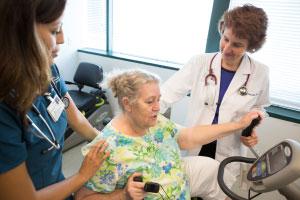 DorAnne Donesky (right) and respiratory therapist Brenda Gallegos (left) work with a patient, teaching her to exercise safely without overtaxing her lungs. “Our goal in the continuing education program is to learn from each other and welcome students who would like to become champions where they practice, regardless of specialty,” says Donesky. In just the first year, those potential champions included Roe, a vascular neurologist at Kaiser Permanente, a nurse who works at Laguna Honda Hospital and Rehabilitation Center and a nurse from the UCSF Neurointensive Care Unit, who is the palliative care champion for her floor.
DorAnne Donesky (right) and respiratory therapist Brenda Gallegos (left) work with a patient, teaching her to exercise safely without overtaxing her lungs. “Our goal in the continuing education program is to learn from each other and welcome students who would like to become champions where they practice, regardless of specialty,” says Donesky. In just the first year, those potential champions included Roe, a vascular neurologist at Kaiser Permanente, a nurse who works at Laguna Honda Hospital and Rehabilitation Center and a nurse from the UCSF Neurointensive Care Unit, who is the palliative care champion for her floor.
“If we can at least create champions who have enough training to coordinate primary palliative care, who can be there if a bedside provider has a question or needs access to a specialty consultation, and who can lead QI [quality improvement] or educational processes in a unit, we can truly integrate palliative care into the fabric of what we do in the hospital every day,” says Anderson.
She hopes, for example, this could lead to more frequent, proactive screening for palliative care needs and more support for clinicians to conduct those screens. The key is teaching clinicians from all different disciplines to recognize palliative care concerns and to be able to effectively assess the depth of the need.
“For example, it’s a common misperception that the chaplain is called in only for a religious concern, but spiritual needs go beyond that, and chaplains are particularly adept at recognizing when people are struggling to cope with their illness, undergoing such severe existential stress that they are exacerbating their symptoms.” Training with a chaplain helps other team members recognize this concern and understand better how to optimize the use of the chaplain in delivering these essential services.
Different Expertise for Different Situations
While a number of programs hoping to scale up quickly on palliative care training focus on online programs, Donesky says, “Our niche is in-person training, and we do a lot of role-playing; it is very high touch. For palliative care, seeing the body language, hearing inflections, seeing where everybody is sitting – we believe [all that is] really important.”
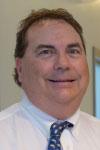 Mark Holtsman Each of the team members brings a different expertise and perspective to the curriculum. Holtsman, for example, co-directs the inpatient pain service at UC Davis Medical Center and brings experience from an interdisciplinary, case-based course he developed on pain management and palliative care for pharmacists. In his practice as a palliative care consulting pharmacist, he brings expertise in how to work through complex problems and find alternative drugs or alternative routes to optimize pain relief and minimize side effects.
Mark Holtsman Each of the team members brings a different expertise and perspective to the curriculum. Holtsman, for example, co-directs the inpatient pain service at UC Davis Medical Center and brings experience from an interdisciplinary, case-based course he developed on pain management and palliative care for pharmacists. In his practice as a palliative care consulting pharmacist, he brings expertise in how to work through complex problems and find alternative drugs or alternative routes to optimize pain relief and minimize side effects.
“I talk to learners about measuring both pain scores and function, because if an analgesic is working, you should be able to measure improvement in function,” he says. “I also talk about what addiction looks like, especially how function decreases quickly when addiction is present, and how to monitor for that and respond appropriately.”
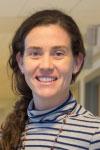 Bridget Sumser For her part, Sumser says that many of the principles found in all social work training are very congruent with palliative care. “We want people to understand how to think about patients as human beings who exist in the world outside their diagnosis. Who is this person? What do they do? Who is important in their life? What stories are they telling about their illness?” she says. “These questions should be central to all conversations, but that’s amazingly hard to do for people who’ve been trained to think about patients and diagnoses.”
Bridget Sumser For her part, Sumser says that many of the principles found in all social work training are very congruent with palliative care. “We want people to understand how to think about patients as human beings who exist in the world outside their diagnosis. Who is this person? What do they do? Who is important in their life? What stories are they telling about their illness?” she says. “These questions should be central to all conversations, but that’s amazingly hard to do for people who’ve been trained to think about patients and diagnoses.”
She says to make the transition, modeling is essential, because it’s contagious and helps all members of the team gain new insights into patient care, as well as the ways the team can work together.
Joseph – who is both a chaplain and a mental health professional and who has spent a decade on the UCSF palliative care team – says, “I address the spiritual, religious and emotional well-being of patients, but I’m also very interested in that aspect for clinicians, because clinician well-being is directly correlated with patient well-being, and the rate of burnout among palliative care clinicians is trending upward.”
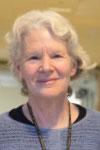 Denah Joseph In the curriculum, she has introduced a number of evidence-based best practices for clinician well-being. “Being able to bear witness and stay present through suffering is important, but compassion and empathy often decline over time, so the training is designed to consciously counter that,” she says.
Denah Joseph In the curriculum, she has introduced a number of evidence-based best practices for clinician well-being. “Being able to bear witness and stay present through suffering is important, but compassion and empathy often decline over time, so the training is designed to consciously counter that,” she says.
The team agrees that developing the role of each of the disciplines and refining how they work together will be critical to the long-term success of palliative care. “It’s hard work to develop a curriculum with the perspectives of all the disciplines present, but if we are simply engaging in parallel play rather than truly working together and listening to each other, it is not likely to be as beneficial for patients,” says Donesky.
To truly function as an integrated palliative care team, says Donesky, often demands a flattened hierarchy, with each discipline taking the lead depending on the needs of each individual patient.
“There are some situations in health care where it is important to have one leader. But in specialty palliative care, we have to understand and honor the expertise of different disciplines, and that’s what we’re trying to do in the continuing education class,” says Anderson.
“The physicians I work with [in palliative care] recognize when a patient’s primary needs are psychosocial, and that it might be most appropriate, for example, for the social worker to take the lead on guiding care,” says Donesky. “But the way we’ve all been trained, it’s not always easy for other disciplines to assume leadership. I think delving much deeper into this dynamic than we have ever gone before is critically important.”
An Evolving Approach
Donesky says that because all of this is relatively new, the course must continually evolve in response to the input of the working professionals doing the learning.
“We talk a lot about the ideal versus what seems to be happening versus where it seems to be heading,” she says. “When we train together, we begin to listen with different ears. One interaction, one patient care collaboration at a time, we are all part of creating the solutions, and we are very committed to creating a community of practice where we all support each other regardless of where we work.”
Each year, UC San Francisco School of Nursing is ranked among the top graduate schools in the nation. Please visit the section of our website on palliative care education to learn more about our work in this area.

The Learning Professionals in Their Own Words
Liz Cahill is a vascular neurologist and neurohospitalist at Kaiser Permanente.
 Liz Cahill I’m interested in how to create more effective palliative care for neurology patients. People with minor strokes, for example, often have to deal with depression, anxiety, feeling unattractive. I used to wait until a patient was distressed, but now I incorporate screening for symptoms into standard care. This offers patients a better quality of life, which might even help with compliance and better health outcomes. There is a lot of potential here, but I received almost no training in palliative care during medical school, so I took the UCSF course as a way to learn if there was more I could do to help my patients and their families.
Liz Cahill I’m interested in how to create more effective palliative care for neurology patients. People with minor strokes, for example, often have to deal with depression, anxiety, feeling unattractive. I used to wait until a patient was distressed, but now I incorporate screening for symptoms into standard care. This offers patients a better quality of life, which might even help with compliance and better health outcomes. There is a lot of potential here, but I received almost no training in palliative care during medical school, so I took the UCSF course as a way to learn if there was more I could do to help my patients and their families.
I learned new approaches to symptom management and a better understanding of when to call in a palliative care consult, but I particularly valued the “vital talk” portion of the course. I’ve never been a big fan of role-playing, but it was invaluable to watch and critique people – and be critiqued – on these conversations, to hear how real-life situations sounded to a social worker, chaplain, nurse, advanced practice nurse.
The course changed how I approach family meetings. Even if I’m running late, I take a couple of minutes to see what everybody on the team finds important – we can do it really quickly, and it actually ends up being time-saving. The different perspectives help identify who might be better equipped to talk about what, and remind us that we shouldn’t assume our perspective is the one the family will have. A nurse who has been with the family for a few days will have a connection that the rest of us don’t, and it’s helpful to recognize and respect that.
Tawnya Napoli has been a nurse in the UCSF Neurointensive Care Unit for the past 11 years and is co-chair of its palliative care committee.
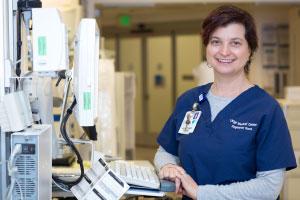 Tawnya Napoli For me, it began with end-of-life issues. I’d watch family meetings being done in a hallway somewhere, and there was no real framework or organization for supporting the process. Eventually, my co-workers and I created a palliative care committee for the Neuro ICU.
Tawnya Napoli For me, it began with end-of-life issues. I’d watch family meetings being done in a hallway somewhere, and there was no real framework or organization for supporting the process. Eventually, my co-workers and I created a palliative care committee for the Neuro ICU.
Then when Wendy Anderson gave a communication workshop to our team, it opened my eyes to palliative care beyond end-of-life care, and opened the door to more education. When I heard about the interprofessional course last year, I filled out the application within one hour of receiving it. Our cohort, about 15 of us, was very diverse, and for case studies, each of us would apply our own skill set, which made the learning much richer.
I’m now one of the Neuro ICU’s palliative care champions. During shifts, we mentor other nurses who need assistance with the process, and we have also done two-hour trainings with about a dozen Neuro ICU nurses; some have also taken a daylong communication course and two-day palliative care nurse training. We also do quarterly meetings and updates and review of practice to keep everybody engaged.
My own comfort level is much higher than it’s ever been. I’m better at seeing symptoms and advocating for the right medication and dosing. For family talks, I literally ground myself outside the room, take a few deep breaths and meet the intensity in that room at a level that makes the conversation more helpful. As nurses, we are very used to explaining things like blood pressure while we’re going about our usual duties, but I’ve learned how to stop and really check in with how people are doing. They often start by talking generally about what they are worried about, but it can move quickly to them saying something very important you can bring back to the team. Recently, a sister was next of kin for her brother who’d had a big stroke. The physicians told her they couldn’t predict where he’d be in six months. After the physicians left, she told me if he couldn’t play the guitar and listen to music, there is no way he would want to be in that condition. We brought the doctor back, and he was great, very clear that the man would not be playing guitar. That was a huge relief for the sister, because she knew what his wishes were and could now make a decision about the support and type of care to provide.
Hong Yuan is a registered nurse at Laguna Honda Hospital and Rehabilitation Center and operates a small board and care home for older adults whose families can no longer care for them.
 Hong Yuan Before I took the class, I was just thinking palliative care was for people close to the end of life. But since the class, I understand it is much more than that, for many more people. You can still have disease-focused treatment done, but palliative care can make a big difference in quality of life. The class really changed my little business, because now I can have much better talks with families, where I explain what palliative care is. In Mandarin, the words for palliative care and hospice are almost the same, so before the course, if I talked about this, the family would be afraid because they would feel as though their loved one were already dead. Now we can talk about comfort and about how to take care of an older adult and the family during an illness or during the end of life. It’s really made a difference.
Hong Yuan Before I took the class, I was just thinking palliative care was for people close to the end of life. But since the class, I understand it is much more than that, for many more people. You can still have disease-focused treatment done, but palliative care can make a big difference in quality of life. The class really changed my little business, because now I can have much better talks with families, where I explain what palliative care is. In Mandarin, the words for palliative care and hospice are almost the same, so before the course, if I talked about this, the family would be afraid because they would feel as though their loved one were already dead. Now we can talk about comfort and about how to take care of an older adult and the family during an illness or during the end of life. It’s really made a difference.
Bernardita Roe is a nurse practitioner who supports the palliative care consultative team at Washington Hospital Healthcare System.
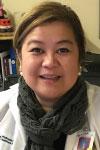 Bernardita Roe Our hospital has been talking about having a palliative care program for years. I was asked to help support the program a couple of years ago, but I declined because I assumed palliative care meant primarily dealing with death and dying, and I didn’t want to do that. I wanted to work as a nurse practitioner in oncology and went to Stanford to do that for about a year, and over that time, I realized palliative care might be more my path. So when they asked again, I agreed. But as I started working on policies and procedures, I realized I needed to learn more, and that’s how I wound up in the program.
Bernardita Roe Our hospital has been talking about having a palliative care program for years. I was asked to help support the program a couple of years ago, but I declined because I assumed palliative care meant primarily dealing with death and dying, and I didn’t want to do that. I wanted to work as a nurse practitioner in oncology and went to Stanford to do that for about a year, and over that time, I realized palliative care might be more my path. So when they asked again, I agreed. But as I started working on policies and procedures, I realized I needed to learn more, and that’s how I wound up in the program.
The course gave me a really good foundation. They provided articles and resources, and the speakers were leaders in palliative care in the Bay Area – Garrett Chan, Kathleen Puntillo, BJ Miller – and there were panel discussions with medical providers, social workers, chaplains and supportive staff. Their take was really eye-opening.
Bedside nurses already provide a kind of primary palliative care, but to align care with the family’s wishes, we need more tools. These are difficult conversations, which people at the front line don’t always have time to do – and they might also need help addressing symptoms for complicated problems.
Since I took the class, our palliative care consultative team has gone live. I worked with our EMR team to develop ways of documenting patient summaries and family conferences. We created a palliative care video education series, which patients and families can watch on our InHealth TV station. And we’ve introduced our services throughout the hospital to help our colleagues understand how palliative care can help patients with serious illness and their families who are suffering improve their quality of life while receiving medical treatment. You’d be surprised how many clinicians still equate palliative care with hospice and, consequently, are reluctant to ask for a consult.
The reception so far varies among clinicians, in part because we are still wrestling with challenges, including convincing people to ask for our help. We need to show this works and why it’s effective, and slowly people will catch on. That is my hope.


